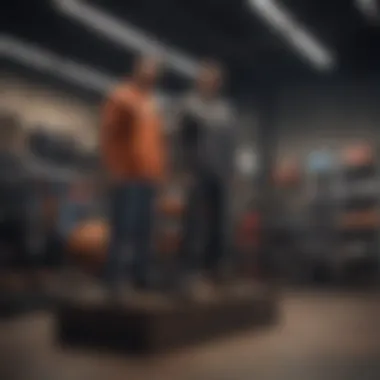Convenience and Strategy: Online Clothing Orders for Pickup


Intro
The shift towards online shopping has become prominent in recent years. More consumers value convenience and efficiency in their retail experiences. One innovative approach consumers have embraced is the option of ordering clothes online for in-store pickup. This method marries the digital benefits of e-commerce with the immediacy of physical shopping. However, understanding this process entails examining both advantages and potential concerns that come with it.
The rise of ordering clothes online for in-store pickup represents a revolution in consumer behavior. Retailers face new challenges but also opportunities to enhance customer satisfaction. To provide a comprehensive guide, this article will explore the key points regarding this shopping method and its implications on strategy for modern retailers.
Evolution of Online Ordering for In-Store Pickup
The concept of ordering clothing online for in-store pickup has its roots in the broader evolution of retail. In the past decade, online shopping gained immense popularity, driven by increased internet access and mobile device usage. As e-commerce grew, retailers adapted to the changing landscape by offering services that allowed customers to conveniently navigate both online and brick-and-mortar environments. The main aim of this service is to combine the ease of online shopping with the instant gratification of in-store experience. It offers a solution to issues such as shipping delays and the uncertainty of fitting clothes.
Advantages of Ordering Clothes Online for In-Store Pickup
The benefits of this shopping method are numerous. Firstly, ordering online allows consumers to browse an extensive range of clothing without feeling rushed in a store. It facilitates informed decisions, often accompanied by reviews and product details. Once an order is placed, customers can pick up items at their convenience, which saves time compared to traditional shopping.
Secondly, in-store pickup often allows for immediate exchanges and returns. Consumers can fit their items in-store and handle any issues right away. This improves user experience and helps build loyalty to the retailer. Many retailers also extend exclusive discounts for in-store pickups, enhancing the feasibility of this option.
Potential Concerns and Challenges
On the other hand, there are potential concerns tied to this practice. One issue is stock availability. Consumers may order an item online only to find it unavailable in-store upon pickup. The frustration can adversely affect their perception of the retailer, leading to a loss of trust.
Additionally, the traditional in-store experience might suffer as retailers adjust their strategies to focus more on online orders. This change could diminish the customary shopping atmosphere that some consumers value.
To summarize, while the influx of online ordering for in-store pickup presents multifaceted advantages for consumers and retailers alike, it is not without its challenges. It underscores the need for retailers to manage stock effectively and ensure a seamless experience that maintains the balance between digital convenience and traditional shopping enjoyment.
Future Trends in Retail Strategy
As technology continues to evolve, so too will strategies surrounding online orders and in-store pickups. Retailers are likely to invest in integrated systems that provide real-time inventory data. Improved logistics will also become necessary to enhance the efficiency of this approach.
In addition, engaging consumers on various platforms can drive interest and loyalty in these new shopping practices. Social media and mobile apps will play significant roles in how consumers interact with brands and make their purchasing decisions. As consumer behavior transforms, retailers that can adapt quickly will stand to benefit the most.
Prolusion to Online Ordering
Ordering clothes online has become an integral part of modern shopping experiences. This method provides ease and convenience to consumers, allowing them to explore a wide variety of options without the need to physically visit different stores. The rise of online shopping is not just a trend; it reflects significant shifts in consumer behavior, preferences, and expectations within a rapidly changing retail landscape.
The Rise of E-commerce
E-commerce refers to the buying and selling of goods or services using the internet. This model has seen exponential growth over the past decade, driven by advancements in technology, mobile access, and the pandemic's acceleration of online shopping habits. With platforms like Amazon, eBay, and others leading the charge, consumers can browse product selections at their fingertips. This has quite literally revolutionized shopping, allowing consumers to compare prices, read reviews, and make purchases within minutes.
One contributing factor to the rise of e-commerce is the flexibility it offers. People can shop anytime, anywhere, without the constraints of traditional store hours. According to recent market analysis, a significant percentage of shoppers prefer online channels due to this flexibility and the ease of accessing sales and discounts. This shift towards digital retailing is not just about convenience; it encompasses an entire ecosystem of user experience improvements, including personalized recommendations based on browsing history and sophisticated return policies designed to enhance consumer trust.
Consumer Preferences in Shopping
Consumer preferences are evolving. Shoppers are now looking for streamlined processes, saving time and effort in purchasing decisions. The trend towards online ordering for in-store pickup is a prime example of this change. It merges the convenience of online shopping with the immediate satisfaction of in-store experiences. This method provides the best of both worlds, allowing consumers to browse and buy without long wait times for shipping.
The preference for this hybrid model also speaks to the desire for social interaction when shopping. People still enjoy the experience of visiting a store, trying on clothes, and engaging with sales staff. By offering the option to order online and pick up items in-store, retailers retain customer engagement and drive foot traffic, which can lead to additional purchases. Thus, understanding consumer preferences is crucial for retailers aiming to adapt to the current market demands and enhance the overall shopping experience.
Key Insights: The shift to online ordering emphasizes not just convenience but also a changing landscape of consumer expectations. Retailers must keep pace with the blend of online access and in-store interaction to remain competitive in this evolving market.


Understanding In-Store Pickup
In the digital age, the convenience of shopping has shifted dramatically. Understanding in-store pickup is essential for consumers and retailers alike. This method blends the advantages of online shopping with the immediacy of physical retail. With in-store pickup, consumers can browse collections, select items, and place orders without the need to handle shipping logistics. This not only saves on delivery times but also allows for a more tailored shopping experience.
Moreover, this approach encourages foot traffic in stores. Retailers can capitalize on these visits to upsell or introduce customers to new products. Therefore, understanding in-store pickup goes beyond mere convenience; it’s a strategic component of modern retail strategies.
What is In-Store Pickup?
In-store pickup, also referred to as click-and-collect, allows customers to purchase items online and retrieve them at a physical store location. This system provides a bridge between e-commerce and traditional shopping.
When a shopper selects an item online, they can choose to pick it up at their nearest store instead of having it shipped to their home. Once the order is placed, the retailer typically alerts the customer when the item is ready for collection. This process is designed to be straightforward, often taking as little as a few hours.
Retailers often streamline this process through apps or websites, presenting customers with specific instructions on how to collect their items. This option not only serves convenience but also ensures that customers can confidently purchase items that meet their needs without incurring delivery fees.
Benefits of In-Store Pickup
The advantages of in-store pickup are varied and significant. Here are some key benefits:
- Reduced Wait Time: In-store pickup eliminates shipping delays. Customers can often obtain their items the same day they order them.
- Elimination of Shipping Costs: Many retailers do not charge shipping fees when customers opt for in-store pickup, leading to cost savings.
- Flexible Pick-Up Times: Customers can choose a time frame that works best for their schedule. This flexibility is a distinct advantage over traditional delivery methods.
- Immediate Access to Products: Shoppers can inspect items for size and quality upon pickup, ensuring satisfaction.
- Potential for Impulse Buys: When visiting the store for collection, customers may discover additional items, contributing to increased sales for retailers.
In-store pickup merges the efficiency of online shopping with the tactile benefits of a physical store experience.
Collectively, these benefits illustrate why understanding in-store pickup is vital for shoppers seeking convenience and effectiveness in their retail journeys. Retailers who leverage this option can enhance customer loyalty, increase sales, and streamline their operations.
Step-by-Step Guide to Ordering Clothes Online
Ordering clothes online for in-store pickup has become a popular option for many consumers. This method combines the ease of online shopping with the immediacy of in-person transactions. The importance of comprehending this process lies in its ability to enhance efficiency and convenience while meeting the evolving needs of shoppers.
Choosing the Right Retailer
Selecting a retailer is a crucial step in the online ordering process. Research potential stores not only based on product offerings but also customer service and return policies. Reputable retailers like Target or Macy’s often provide a seamless online experience. Reviews and ratings should factor into your decision. If a retailer is known for poor customer service, it may lead to complications during the ordering process.
- Look for retailers that offer a good range of sizes and styles.
- Ensure they have a reliable in-store pickup system.
- Investigate their policies regarding prices and promotions, as some may have exclusive deals for online shoppers.
Navigating the Online Store
Once a retailer is selected, understanding how to navigate their website is essential. Online platforms can vary significantly in layout and functionality. Pay attention to filters to sort items by size, color, or price. This can save time and provide a more efficient shopping experience.
- Familiarize yourself with the search function. Sometimes, finding the right piece can be challenging without it.
- Read descriptions and reviews to gauge product quality.
- Check stock availability at your local store to avoid disappointment when you arrive to pick up your order.
Scheduling Your Pickup
After selecting your items and placing your order, you will need to schedule your pickup. This step is essential as it helps coordinate when your items will be ready for collection, avoiding unnecessary waiting.
- Choose a pickup time that suits your schedule. Many retailers offer flexible pickup times.
- Follow any specific instructions provided by the retailer regarding your arrival.
- Keep an eye on confirmation emails or texts, as they often contain crucial details for pickup.
Remember, timely communication with the retailer regarding any changes can enhance the overall service experience.
Challenges of Online Orders with In-Store Pickup


The convenience of ordering clothes online for in-store pickup comes with its own set of challenges. Understanding these hurdles is essential for both consumers and retailers. Awareness of these issues can guide smarter shopping choices and improve operational strategies. Without acknowledging these challenges, customers may encounter frustration, while businesses might face inefficiencies that impact their bottom line.
Inventory Management Issues
One of the core challenges in the context of online orders for in-store pickup is inventory management. Maintaining accurate inventory levels across online platforms and physical stores is complex. Many retailers struggle to synchronize their stock information. This can lead to situations where items are marked available online, yet are out of stock when the consumer arrives for pickup.
Additionally, over-reliance on automated systems can create errors. A misstep in the inventory data might mean that customers could be notified that their selected items are ready, while, in reality, they are not. This not only creates a disappointment for shoppers but can also lead to increased operational costs as employees devote time to resolving discrepancies.
Time Constraints
Time constraints are another significant factor that complicates the online ordering process with in-store pickup. Busy schedules often dictate shopping habits, pushing consumers towards the idea of efficiency. The expectation is that once an order is placed, it will be ready for collection without delay. However, reality is often different. Delays can occur for various reasons, including unforeseen inventory shortages or logistical hiccups in the preparation of orders.
When customers plan to visit a store for pickup, they do not typically factor in additional wait times. If a shopper has allocated a specific period to collect their order, any delay can disrupt their plans. This highlights the need for retailers to communicate effectively about expected wait times and to provide transparent updates throughout the ordering process.
Effective communication and precise inventory management are crucial for reducing frustrations associated with online orders for in-store pickup.
The increasing prevalence of online shopping illustrates a shift in consumer expectations toward speed and reliability. Recognizing and addressing these challenges not only enhances the shopping experience for consumers but plays a vital role in shaping retail strategies moving forward.
Comparative Analysis: Online vs.
In-Store Shopping
The rise of online ordering for in-store pickup has led to an intricate relationship between traditional shopping and digital avenues. As consumers increasingly embrace the dual nature of shopping, it becomes essential to understand the comparative advantages of each. This analysis highlights specific elements such as efficiency, speed, tactile experiences, and customer service in determining why some consumers prefer one method over the other.
Efficiency and Speed
Efficiency is a key factor in the shopping experience. The online model particularly shines with its capacity for speed. Customers can navigate through digital catalogs in a matter of minutes. This rapid access to products can significantly reduce the time spent on shopping. In-store experiences, on the other hand, often involve traveling, parking, and navigating through crowded aisles, which can extend the overall time commitment.
Online platforms allow for quick searching and filtering options. With the right keywords, a consumer can locate their desired items without unnecessary delays. With systems that save shopping preferences and previous orders, users can streamline their future transactions even more. This leads to shorter wait times for order processing.
However, delays may occur in the order fulfillment process or during high-demand periods. Issues can arise when items are out of stock, which can lead to longer waits for customers depending on restocking schedules. Balancing this with instant gratification offered at physical stores is a consideration consumers must weigh.
!> Online platforms can provide a speedier process of identifying and purchasing desired items, but in-store shopping may allow immediate possession of items.
Tactile Experience and Customer Service
On the other hand, tactile experience remains a significant advantage for in-store shopping. The ability to touch, try, or even feel the fabric is crucial for many customers, particularly in clothing purchases. Many consumers prefer to ensure the fit and feel of an item before committing to it. Trying on clothes, checking fabric quality, and assessing complexion compatibility with specific colors are aspects unavailable in the online realm.
Customer service differs as well. In-store shopping provides instant access to sales associates who can help with product questions, sizing issues, or recommendations. Engaging with a knowledgeable staff member can enhance the shopping experience, providing a personalized touch that online platforms may lack. On the flip side, online shopping offers convenience in customer support through chat options, email, or phone interactions. However, the immediacy of face-to-face interaction is absent.
As both shopping platforms evolve, retailers need to find a balance that utilizes the advantages of both efficiency and tactile experiences. An informed choice depends on individual preferences and priorities, blending the convenience of online shopping with the sensory engagement of in-store visits.
Impact on Retail Business Models
The evolving landscape of retail is deeply influenced by the rise of online orders with in-store pickup. This shift not only changes how consumers shop but also forces retailers to reevaluate their entire business model. Understanding this impact is essential for retailers aiming to remain relevant and competitive.
One significant aspect is the need for agility in operations. Retailers must quickly adapt to fluctuating customer demands, which are increasingly leaning towards convenience. By offering online orders with in-store pickup, stores can maintain their physical locations while catering to a more digitally-savvy customer base. This practice allows customers to enjoy the immediacy of shopping without the cost of shipping, thus balancing both online and offline experiences effectively.


Adapting to New Consumer Behaviors
Consumer behavior has seen a notable transformation. Modern shoppers expect seamless experiences across all platforms. Retailers must understand how to meet these expectations by integrating their digital and physical strategies.
- Omni-channel Shopping Experience: Consumers value the ability to switch between online and physical shopping effortlessly. Retailers should focus on creating a coherent system that allows for easy navigation between channels.
- Personalization: Using data analytics, retailers can tailor offerings to individual preferences, enhancing the customer experience. This adaptation can improve satisfaction and loyalty.
- Convenience and Speed: Consumers prioritize swift services. By optimizing in-store pickup processes, retailers can significantly enhance customer experience, making shopping more attractive.
Technological Innovations
To successfully implement an effective model for online orders and in-store pickup, technological innovations play a crucial role. Retailers must invest in technology that not only meets current demands but anticipates future trends.
- Inventory Management Systems: Advanced systems help to keep track of stock levels, ensuring that the right items are available for pickup. This can prevent lost sales and enhance customer trust.
- Mobile Applications: Retailers should develop user-friendly apps that streamline the ordering process. These apps can include features such as notifications when items are ready for pickup, thereby creating ease for the consumer.
- Data Analytics Tools: Utilizing data can help retailers understand shopping patterns and preferences. Over time, this can lead to better decision-making in stock management and marketing strategies.
By embracing these strategies, retailers can mitigate risks associated with changing consumer behaviors while capitalizing on the benefits of technological advances.
The Future of Online Orders and In-Store Pickup
The concept of ordering clothes online for in-store pickup reflects a shift in retail strategies driven by technological advancements and changing consumer expectations. As e-commerce continues to grow, understanding the future of this model is crucial for retailers and consumers alike. The interplay between convenience and strategy will shape shopping behaviors significantly in the coming years. Particularly, technology and consumer habits will determine how attractive and effective the online ordering system becomes.
Emerging Trends
Several trends are emerging in the realm of online orders and in-store pickup. These trends show how retailers are adapting to consumer demands and evolving technology:
- Personalization: Retailers are leveraging data analytics to offer customized shopping experiences. By analyzing customer preferences and past purchases, stores can suggest tailored recommendations.
- Mobile Integration: An increase in smartphone usage is influencing shopping behaviors. Retailers are optimizing their websites and apps for mobile devices, making it easier for customers to order on the go.
- Contactless Options: In response to health concerns, many retailers are providing contactless payment and pickup options to enhance safety during transactions.
- Real-time Inventory Management: Emerging technologies allow retailers to update online inventory in real-time. Shoppers can see product availability immediately, reducing disappointment upon arrival at the store.
- Community Engagement: Retailers focus on building relationships with their local communities. Offering exclusive deals or events for local customers encourages more in-store visits.
These trends indicate a proactive approach by retailers to meet customer demands and position themselves competitively in the market.
Sustainability Considerations
Sustainability increasingly plays a role in shopping decisions. As consumers become more environmentally conscious, retailers must adjust their practices. Here are some key points regarding sustainability in the context of online orders and in-store pickup:
- Reduced Carbon Footprint: Utilizing in-store pickup can lower overall emissions compared to home delivery. Fewer delivery vehicles on the road means less pollution.
- Eco-friendly Packaging: Retailers are moving toward minimal and recyclable packaging options to reduce waste. This shift appeals to consumers who prioritize sustainability.
- Promoting Local Products: By encouraging purchases of locally sourced items, stores can support community businesses and reduce transportation emissions.
- Educating Consumers: Retailers can play a role in promoting sustainable practices through their platforms. Offering information on product sourcing and environmental impact can enhance consumer awareness.
These considerations reflect a broader societal push toward sustainability in retail. This movement aligns with consumer values and can foster deeper brand loyalty.
Ending
In a world where consumer habits are continually evolving, the convenience of ordering clothes online for in-store pickup stands out as a significant shift in retail strategies. This conclusion underscores the importance of understanding this model, catering to both consumers' desire for efficiency and retailers' need to adapt to changing environments.
The advantages of this method are multifold. Firstly, it allows customers to bypass shipping delays, and retrieve their merchandise almost immediately at their chosen location. Secondly, it mitigates issues related to sizing and product quality, as consumers can physically interact with the item before committing to a purchase. Furthermore, the in-store pickup often leads to an increase in foot traffic, which may encourage additional impulse purchases.
However, there are several considerations that need attention. Retailers must be mindful of inventory management to ensure products are available when promised. Also, logistical challenges can arise, such as maintaining accurate delivery timelines. Customers need to be informed on how to navigate the process seamlessly, reducing potential frustrations associated with their shopping experience.
“The balance between online convenience and in-store experiences is crucial for the future of retail.”
Looking ahead, the trend of online orders with in-store pickup is likely to grow. Businesses must focus on creating a smooth omnichannel experience. This includes investing in technology that synchronizes online and in-store inventories, enhancing customer service, and offering personalized shopping experiences. Ultimately, adapting to these mechanisms will ensure that retailers remain relevant amidst competition and technological advancements.
Final Thoughts on Convenience and Its Implications
The shift towards convenience in retail through online orders for in-store pickup is a reflection of consumer expectations today. Fast-paced lifestyles necessitate efficient shopping solutions. This model not only satisfies those needs, but also reshapes the relationship between consumers and retailers.
From the perspective of an extreme sports enthusiast or a young adventure seeker, this method enables quick access to gear and clothing. Ordering a new jacket or pair of shoes online and picking it up allows for immediate preparation before heading out on a new trail or adventure.
Furthermore, this blend of digital and physical shopping fosters a more engaging retail experience. It prompts retailers to enhance product presentations and in-store interactions, ensuring consumers leave with satisfactory purchases.
In summary, the implications of convenience and strategy in online ordering for in-store pickup are profound. A deeper understanding of these concepts not only benefits consumers but also provides valuable insights for retailers aiming to innovate and thrive in a competitive market.















